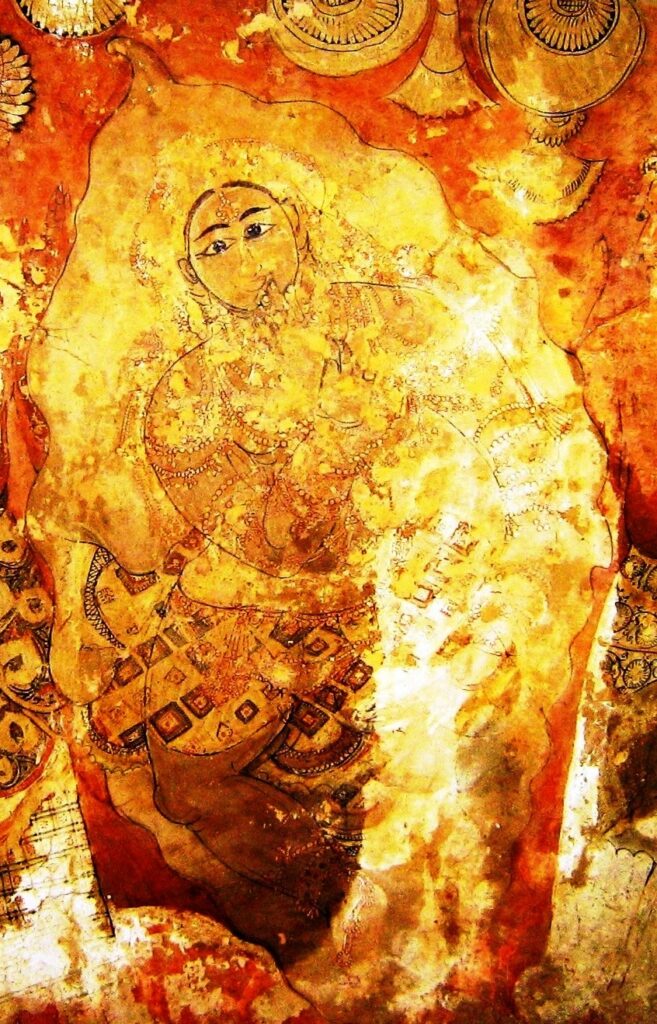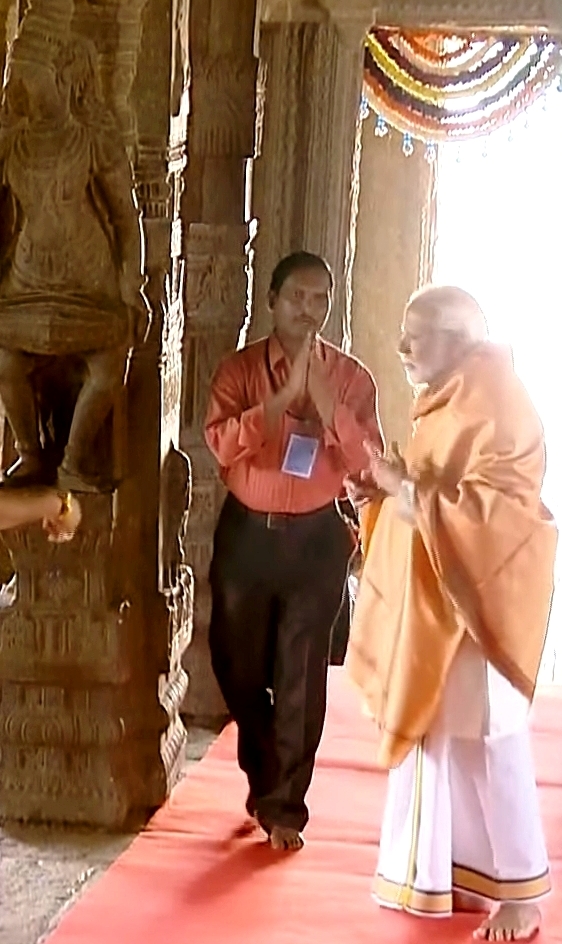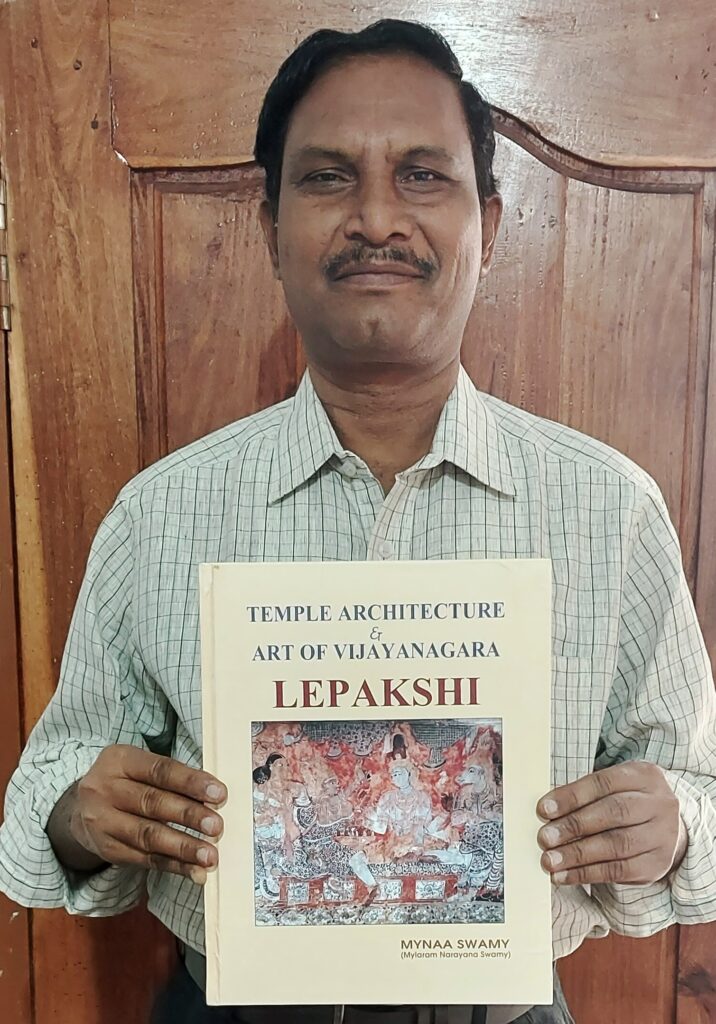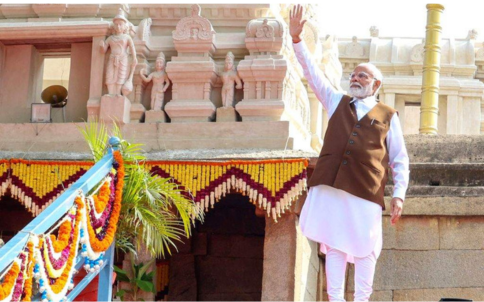Historian MyNaa Swamy becomes interpreter
Lepakshi(Andhra Pradesh-India): Prime Minister Narendra Modi was captivated by the wealth of Lepakshi sculptures in Andhra Pradesh. He was enthralled by the beautiful form of Moola Virat-Dhyana Mudra, the wrathful form-oil painting of Sri Veerabhadra Swamy, the hanging pillar, Vatapatra sayee, and the marvelous sculpture of Bhikshatanamurthy. On the 16th January 2024, Modi visited Lepakshi Veerabhadralaya and was amazed to see Lepakshi’s sculptural wealth, particularly the oil paintings which serve as direct evidence of the cultural magnificence of the Vijayanagara Empire. The Prime Minister, who witnessed the grandeur of the Vijayanagara era firsthand, was left in awe. It is worth noting that historian MyNaa Swamy acted as the guide and interpreter during the Prime Minister’s visit to the temple, a rare occurrence indeed.

Vatapatrasai painting
On the 16th January 2024, Modi visited Lepakshi Veerabhadralaya and was amazed to see Lepakshi’s sculptural wealth, such as oil paintings, which serve as direct evidence of the cultural splendor of the Vijayanagara Empire. The Prime Minister, who witnessed the splendor of the Vijayanagara era firsthand, was in awe. Historian MyNaa Swamy had the rare privilege of acting as the guide and interpreter during the Prime Minister’s visit to the temple. MyNaa Swamy’s book on Lepakshi created a sensation when it was published in three languages and efforts are being made to publish it in two more languages. After completing the special rituals, recitation of sacred verses, and puppet show, Prime Minister Modi walked around the holy center. Later, the Prime Minister observed a 25×14 feet oil painting of Veerabhadra Swamy on the roof of the main hall. Historian MyNaa Swamy provided an explanation to the Prime Minister regarding the various aspects of the weapons in ten hands, a long sword, and the significance of beheading Dakshaprajapati during Dakshayagna. Moolah Virat is portrayed with four arms and in Dhyanamudra. The oil painting differs from the depiction of the ten-armed Mahagrarupa. When asked to identify the discrepancy, Modi carefully examined both forms.

Hanging Pillar: Prime minister was impressed by the enormous pillars, sculptures, and oil paintings that adorned in the ceiling of the dance hall. MyNaa Swamy placed a thin cloth underneath the sky pillar, ensuring it did not touch the ground, and the Prime Minister himself removed it from beneath the pillar. He observed the hanging pole with curiosity and inquired about its significance. The hanging pillar and the adjacent pillar are in the Chola style, while the two other large pillars are in the Hoysala style. The remaining pillars are in the Vijayanagara style, and the prime minister listened intently to the explanation.
Vatapatra sayee: Kiratarjuniyo in Mahabharata- Aranyaparvam, Girija Kalyanam in Shiva Purana, Virupanna, and the temple builder who received the blessing of Virabhadra – his retinue, Vatapatra sayee oil paintings in Markandeya Purana were examined When MyNaa Swamy explained about the Gathas- Vatapatra sayee color image; Modi noticed that Balakrishna’s eyes were painted from three angles. The Prime Minister admired the skill of the sculptors and artists from Vijayanagar and paid his respects.
Bhikshatanamurthy: On the left side of the dance hall, he saw the magnificent form of Bhikshatanamurthy. Bhakti listened attentively as the historian discussed the distinctions between the Vijayanagara sculptural style and other styles of Bhikshatanamurti idols. Readers are aware that Narendra Modi represents Lok Sabha from Shaiva Purana Kshetra-Kashi.

Historian MyNaa Swamy hopes that with the arrival of the Prime Minister, Lepakshi light will not only spread in all directions but also contribute to the development of the backward Rayalaseema. In the meantime, the Veerabhadra Swamy temple was built by Nandi Virupanna, the son of Nandi Lakkishetty-Muddamambala of Penukonda in 1531. According to the Chalivendula inscription dated August 6, 1531, Vijayanagara emperor Sambeta Achyuta Deva Raya (brother of Sri Krishna Deva Raya) helped in every way to build the temple. The temple complex contains approximately 20 inscriptions. Recently, MyNaa Swamy placed the north-facing ‘Tulu Prashasti’ inscription on the second prakara wall. The inscription was written by Achyuta Devaraya in 1533. Furthermore, MyNaa Swamy successfully organized a national conference on December 14 and 15, 2022, with the aim of seeking recognition from ‘UNESCO’ for the Lepakshi Veerabhadralaya complex.
Meanwhile..MyNaa Swamy’s research book ‘Architecture and Art of Vijayanagara- Lepakshi’ became popular.( MyNaa Swamy can be reached..9502659119)




